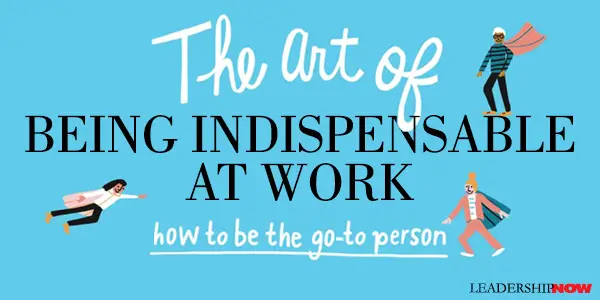 |
 |
03.16.21

The Art of Being Indispensable at Work
WHO doesn’t want to be that indispensable go-to person? To do that, though, it seems like you must say yes to everybody and everything. To overcommit. Bruce Tulgan, the author of The Art of Being Indispensable at Work, says overcommitment actually gets in the way of being that go-to person. The process of trying to become indispensable too often means stretching oneself beyond human capacity so that priorities become muddled. Important tasks are left undone or done ineffectively. All of this might leave you wondering when all of this collaboration business is going to blow over so that you can get back to doing your real job. In short, we all need to work together. When we help others succeed, we all succeed. It not good enough for one department to get it right. All departments need to get it right with coordinated responses that are aligned with the company strategy. The way of the go-to person is not to do everything for everybody. That only leads to the overcommitment syndrome. But they do as much as they can do well. The go-to person approaches “every relationship determined to add value to every interaction and to every other person.” In practice, you may have reservations about how this is even realistically possible. Issues like overwork, lack of accountability, lack of authority, how to say no and yes, arrogance are all addressed by Tulgan. Real influence is what makes the go-to person the go-to person. “Real influence is the power you have when other people really want to do things for you, make good use of your time, and contribute to your success.” The way to build it is by serving others “by doing the right thing for the long-term, moment by moment, adding maximum value in every single interaction.” It is important, too, to “know what is required and what’s allowed—up and down the chain of command—before you try to work things out at your own level.” The key here is alignment. Before you can work things out at your own level, you must be sure that you are aligned with the people making decisions. Good communication up and down the chain of command is how to make sure that happens. Whether to say yes or no is about how you will spend your time. Alignment with the ultimate decision-makers gives clarity to this process for you and allows you to provide clarity for those below you. “Knowing what decisions are not for you to make is like having guardrails. Within those guardrails of vertical alignment is where you have the discretion—the authority and the burden—to field those asks all day long and make tough decisions about yes and no.” Tulgan says you first need to fine-tune the ask. “The ask is the time o drill down before you overcommit or, more likely, before you wrongly commit.” You need to consider what exactly is being asked for, what it will take, and are you able to provide what is needed. Say no when you cannot do it (you don’t have the skill, knowledge, or time), when you are not allowed to do it, or when you should not do it. “Every good no makes room for a better yes.” A successful yes is based on a good plan of execution. That includes working smart and finishing what you start. “Work smart by professionalizing everything you do, specializing in what you do best, and steadily expanding your repertoire of specialties. Know what you want to be known for.” Specializing in what you do best is not just doing what you like best. You must be proficient at all aspects (like paperwork) of what you do or like to do best. Too many people make the mistake of thinking that the key to being a go-to person is being the hardest worker. And hard work is very important, of course. But if you work really hard at doing the wrong things or doing things wrong, you are not adding value. Don’t juggle. You need focus to finish what you start. You can only finish one thing at a time. If you want to be indispensable at work, you need to be known for executing on one important thing after another very well, very fast, all day long. That means powerfully contributing to the value of those things—be they meetings, emails, conversations, research, whatever—by giving them your full focused attention. The go-to person makes a concerted effort to get better and better at working with others. To improve relationships, make gratitude one of your trademarks and opt for continuous improvement. If you are smart, you realize quickly that you cannot be a true go-to person just by being great at the technical aspects of your job. Relationships are critical. But you cannot build the kind of relationships you need by working around the system, sidestepping rules, playing politics or making friends with the right people. You cannot make yourself powerful just by being a steamroller who won’t take no for an answer. Nobody will want you to be successful and powerful either if you turn everything you do into a favor that you add up on a ledger tally, and expect something in return quid-pro-quo style. Becoming a go-to person is not easy and requires practicing the principles presented here over time. These ideas also have benefits outside of work too. Serving others makes you the kind of person others want to help succeed. That kind of influence is indispensable. 
Posted by Michael McKinney at 08:00 AM
|
BUILD YOUR KNOWLEDGE
 

How to Do Your Start-Up Right STRAIGHT TALK FOR START-UPS 
Grow Your Leadership Skills NEW AND UPCOMING LEADERSHIP BOOKS 
Leadership Minute BITE-SIZE CONCEPTS YOU CAN CHEW ON 
Classic Leadership Books BOOKS TO READ BEFORE YOU LEAD |